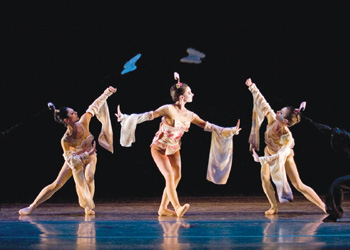![[Metroactive Stage]](/stage/gifs/stage468.gif)
[ Stage Index | Silicon Valley | Metroactive Home | Archives ]

Triad: Alexsandra Meijer (center) is attended by her female companions (from left) Beth Ann Namey and Catharine Grow in 'Shinju.' Zen Bowing Ballet San Jose Silicon Valley probed the precision of balance in Smuin's 'Shinju' By Marianne Messina MICHAEL SMUIN's Shinju, the centerpiece of San Jose Ballet's "Love and Power" program, is as concentrated and tense as a Zen strung bow. The often-contorted poses are frozen in time until sharp percussion cuts the silence and poses suddenly shift, creating hold-your-breath anticipation. The curtain opens on the statuesque lovers (Maximo Califano and Alexsandra Meijer). Their love is forbidden by their warring families. Throughout the dance their movements are highly stylized. The sense of ritual permeates everything, their love, the emblems on the silk drops behind them, their movement, the powerful low, sometimes dissonant drone of male chanting. Love is represented more in poses than in movements, but what poses: Meijer kneeling atop Califano's thigh; Meijer facing the audience straddled across Califano's thighs, and all while he holds impossible turn-out squats. Physically, visually the relationship is one of support. At one point, balancing her horizontally across his upper chest, Califano unfurls Meijer like a tapestry, dropping her from his neck to his knee. Affection comes as slight tips of the head, one toward the other, or arms that encircle but don't touch. Complex visual textures heighten the palpable tension—bold facial makeup against feathery veils (here, Willa Kim on costumes and décor has touched the sublime). When the couple fall asleep, the parents (Karen Gabay and Daniel Gwatkin) come out and discover them. The parents' regal purple robes, their high headdresses or mounds of bound hair all show the weight of accumulated years and responsibility. It is not your typical raging father and weeping mother scene. The slightest gesture says all. Gabay makes radical posture switches balanced on one miraculous toe. But the seasoned Gabay and Gwatkin go beyond skill in this performance, bringing out their formidable inner qualities to bewitch the motionless seconds. The parents separate the two lovers and leave, Gabay hanging backward from one leg crooked around Gwatkin's shoulder. The pose sadly echoes the supportive postures of the younger couple as if to say the younger relationship would have the same regal potential if given a chance. The scene of the ritual suicide (as the title, Shinju, foretells) is gripping—but that's for you to discover and enjoy. Paul Seiko Chihara's score—where every sound and voicing has import—Willa Kim's stunning visual brush strokes and Smuin's brilliant choreography have created a taut alchemy of elements that is pure gold. Framing Shinju's inward fire, the ensemble work of both Cannonade and Quicksilver (choreographed by Dennis Nahat) emphasize interplay (Cannonade) and physical achievement (Quicksilver). The form-fitting costumes come in simple pales or whites (costumes by the late David Guthrie) and seem to liberate the body from the weight of ritual. Cannonade also featured one of the high points of the program in the Alex Lapshin/Alexandra Koltun pas de deux. Set to a Bach adagio, with its slow, almost sinister continuo, the choreography has Lapshin lifting and carrying Koltun in beautiful ways. She hangs upside down; he lowers her onto one knee and spins her slowly, her mantid legs are striking, moving at odds; in fact, all four limbs seem like separate musical voicings. At the Saturday night performance, Koltun managed to transform her body into something elemental, never giving the sense of counting, never seeming anxious to cover space. She literally melted into the music. It was a stellar performance right down to the exit, Koltun balanced horizontally on Lapshin's shoulder—no holds—her hands outstretched to mirror his as they disappeared behind the curtain.
Send a letter to the editor about this story to letters@metronews.com. [ Silicon Valley | Metroactive Home | Archives ]
|
From the April 6-12, 2005 issue of Metro, Silicon Valley's Weekly Newspaper.
Copyright © Metro Publishing Inc. Metroactive is affiliated with the Boulevards Network.
For more information about the San Jose/Silicon Valley area, visit sanjose.com.